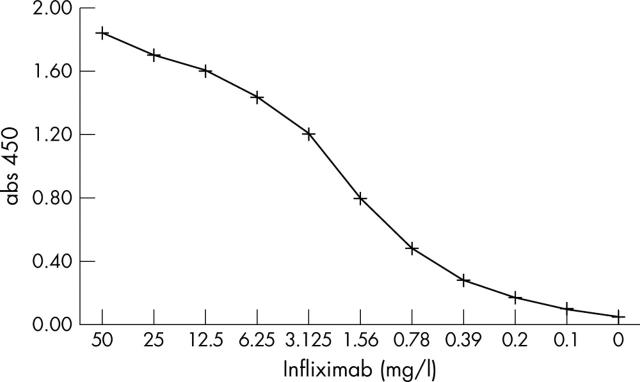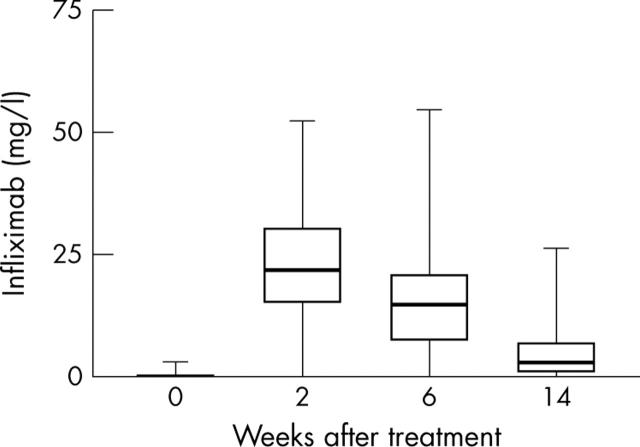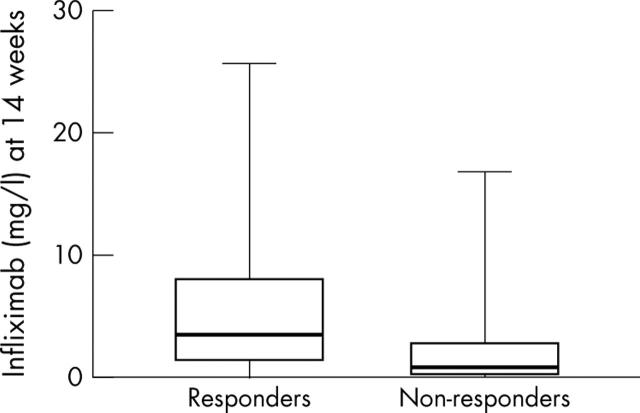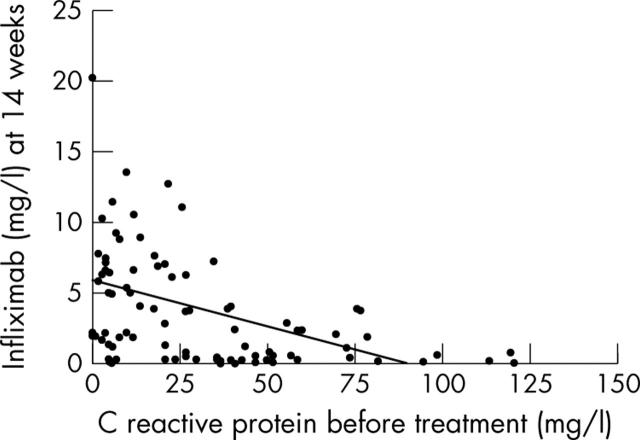Abstract
Objective: To investigate the relationship between serum trough infliximab levels and clinical response to infliximab treatment in patients with rheumatoid arthritis (RA).
Methods: Disease activity and serum trough infliximab levels before and 2, 6, and 14 weeks after initiation of infliximab treatment at a dose of 3 mg/kg in a cohort of 105 patients with RA were assessed. Serum trough infliximab levels in responders and non-responders were compared. Additionally, the clinical responses of patients with high, intermediate, and low serum trough infliximab levels at 14 weeks were compared.
Results: After 14 weeks of treatment non-responders had lower serum trough levels of infliximab than responders (median (interquartile range) 0.5 (0.2–2.2) v 3.6 (1.4–8.2) mg/l; p<0.01)). Patients with low serum trough infliximab levels at 14 weeks had significantly less improvement in the 28 joint count Disease Activity Score (DAS28) score than patients with intermediate or high serum trough infliximab levels at 14 weeks. Pretreatment C reactive protein (CRP) levels correlated negatively with serum trough infliximab levels at 14 weeks after the start of treatment (Spearman rank correlation rs = –0.43, p<0.001).
Conclusion: Serum trough levels of infliximab correlate with the clinical response to treatment with infliximab and pretreatment CRP levels. This study indicates that patients with high pretreatment CRP levels might benefit from higher dosages of infliximab or shorter dosing intervals.
Full Text
The Full Text of this article is available as a PDF (73.4 KB).
Figure 1.
Standard curve of infliximab in the ELISA.
Figure 2.
Serum trough infliximab levels in 105 patients treated with 3 mg/kg infliximab. Data are shown as box-whisker plots, representing the median, 25th and 75th centile, and range.
Figure 3.
Serum trough infliximab levels in patients with RA treated with infliximab according to clinical response at 14 weeks.
Figure 4.
Correlation between serum trough infliximab levels at 14 weeks and CRP values before treatment in patients with RA treated with infliximab.
Selected References
These references are in PubMed. This may not be the complete list of references from this article.
- Arnett F. C., Edworthy S. M., Bloch D. A., McShane D. J., Fries J. F., Cooper N. S., Healey L. A., Kaplan S. R., Liang M. H., Luthra H. S. The American Rheumatism Association 1987 revised criteria for the classification of rheumatoid arthritis. Arthritis Rheum. 1988 Mar;31(3):315–324. doi: 10.1002/art.1780310302. [DOI] [PubMed] [Google Scholar]
- Baert Filip, Noman Maja, Vermeire Severine, Van Assche Gert, D' Haens Geert, Carbonez An, Rutgeerts Paul. Influence of immunogenicity on the long-term efficacy of infliximab in Crohn's disease. N Engl J Med. 2003 Feb 13;348(7):601–608. doi: 10.1056/NEJMoa020888. [DOI] [PubMed] [Google Scholar]
- Fitzcharles Mary-Ann, Clayton Denise, Ménard Henri André. The use of infliximab in academic rheumatology practice: an audit of early clinical experience. J Rheumatol. 2002 Dec;29(12):2525–2530. [PubMed] [Google Scholar]
- Maini R. N., Breedveld F. C., Kalden J. R., Smolen J. S., Davis D., Macfarlane J. D., Antoni C., Leeb B., Elliott M. J., Woody J. N. Therapeutic efficacy of multiple intravenous infusions of anti-tumor necrosis factor alpha monoclonal antibody combined with low-dose weekly methotrexate in rheumatoid arthritis. Arthritis Rheum. 1998 Sep;41(9):1552–1563. doi: 10.1002/1529-0131(199809)41:9<1552::AID-ART5>3.0.CO;2-W. [DOI] [PubMed] [Google Scholar]
- Maini R., St Clair E. W., Breedveld F., Furst D., Kalden J., Weisman M., Smolen J., Emery P., Harriman G., Feldmann M. Infliximab (chimeric anti-tumour necrosis factor alpha monoclonal antibody) versus placebo in rheumatoid arthritis patients receiving concomitant methotrexate: a randomised phase III trial. ATTRACT Study Group. Lancet. 1999 Dec 4;354(9194):1932–1939. doi: 10.1016/s0140-6736(99)05246-0. [DOI] [PubMed] [Google Scholar]
- Sidiropoulos P., Bertsias G., Kritikos H. D., Kouroumali H., Voudouris K., Boumpas D. T. Infliximab treatment for rheumatoid arthritis, with dose titration based on the Disease Activity Score: dose adjustments are common but not always sufficient to assure sustained benefit. Ann Rheum Dis. 2004 Feb;63(2):144–148. doi: 10.1136/ard.2003.015933. [DOI] [PMC free article] [PubMed] [Google Scholar]
- Smolen J. S., Breedveld F. C., Burmester G. R., Combe B., Emery P., Kalden J. R., Klareskog L., Maini R. N., Numo R., van De Putte L. B. Consensus statement on the initiation and continuation of tumour necrosis factor blocking therapies in rheumatoid arthritis. Ann Rheum Dis. 2000 Jul;59(7):504–505. doi: 10.1136/ard.59.7.504. [DOI] [PMC free article] [PubMed] [Google Scholar]
- St Clair E. William, Wagner Carrie L., Fasanmade Adedigbo A., Wang Benjamin, Schaible Thomas, Kavanaugh Arthur, Keystone Edward C. The relationship of serum infliximab concentrations to clinical improvement in rheumatoid arthritis: results from ATTRACT, a multicenter, randomized, double-blind, placebo-controlled trial. Arthritis Rheum. 2002 Jun;46(6):1451–1459. doi: 10.1002/art.10302. [DOI] [PubMed] [Google Scholar]
- van Vollenhoven R. F., Brannemark S., Klareskog L. Dose escalation of infliximab in clinical practice: improvements seen may be explained by a regression-like effect. Ann Rheum Dis. 2004 Apr;63(4):426–430. doi: 10.1136/ard.2003.010967. [DOI] [PMC free article] [PubMed] [Google Scholar]






